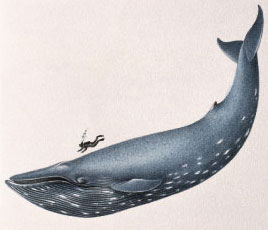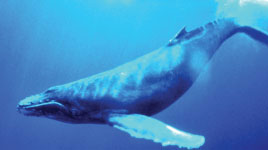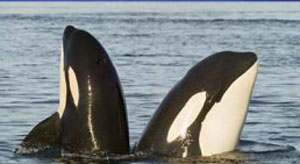|
Nature Trail
Whales:
Giants of the ocean
The whale is one of the largest and most majestic animals to ever
inhabit our planet. Would you believe that it was originally a
four-legged land dwelling mammal which evolved into a sea-dwelling
mammal millions of years ago?

A long,long time ago, the oceans were filled with these animals, who
like us, breathe oxygen, give birth to live offspring and have a complex
family and social structure. However, as is the case with most animals,
humans killed them for food and blubber (fat) and drove this species to
the brink of extinction.Today, even though most countries in the world
have banned whaling, this species is still endangered.
Now, let's check out some interesting facts about these gigantic
creatures the family of which , as most of you may be aware of by now,
has a species that holds the world title as the largest animal on Planet
Earth!It is none other than the blue whale.
The term "whale" is a common name given by scientists for a mammal
under the order of cetacea. This term is mainly used to describe all
members of the whale family; however we most often leave out the dolphin
and porpoise families in this general categorisation.
|

Difference in size
A sketch of a blue whale
and a human. |
There are two main types of cetaceans: They are the Toothed Whales (Odontoceti)
which include orca(killer whales) and sperm whales and also the Baleen
Whales (Mysticeti) including blue whales and humpback whales among
others. The toothed whales are usually smaller and there are around 66
species under this main category. Baleen Whales are usually larger and
have two blowholes instead of one like the Toothed Whales.
There are about ten species of Baleen Whales that can be found today.
The Baleen Whales use long strips of baleen that serve as teeth for
them, to strain the seawater when they are feeding.This is where their
name originated from.
Every physical feature of the whale has undergone changes so that it
is now perfectly adapted to an aquatic life. Modifications in their
systems allow them to dive up to depths of 4000 metres and stay
underwater for as long as an hour.Their bodies have a flawless shape in
which all sensory organs are compressed and therefore reduce the drag
when swimming, allowing them to swim up to speeds of 35km/h, propelled
by powerful lateral tail flukes(up and down tail movements).
Their senses of taste and smell have all but disappeared. They have
extremely poor vision; however, to compensate for all this they have the
most acute and well developed sense of hearing of all living creatures.
Whales can produce and receive sounds--bleeps, whistles, clicks,
moans, and complex "songs"of a range from lower than our lowest hearing
frequency up to thirteen times more than our upper hearing frequency.
The normal and lower ranges are used to communicate over long distances
underwater, and the higher frequencies are used in sonar echolocation to
determine location, identify objects, and find food,often in total
darkness.
|

Blue whale |
Like in most animals where sound passes through the outer ear to the
middle ear, in whales it is recieved from their throat, from which it
passes through a low-impedance, fat-filled cavity, to the inner ear.
The largest whale, which is ofcourse the female blue whale, may grow
up to 100 ft, weigh about 150 tons, and live to be a hundred!
Did you know that the most dangerous natural enemy of this huge
animal is isactually a smallinner-ear parasite? You may be surprised to
learn that whales have also been discovered to have human illnesses such
as ulcers, dental caries and even tonsillitis.
The whale brain is in actual size and by proportion, the largest and
most complex brain of any animal, including humans. It weighs on average
about five and a half times more than a human brain. Since it does not
have any external technology or aid for recording, the whale uses its
brain as a sort of memory file. It stores large amounts of detailed
information regarding culture and environmental data. Experiments with
smaller whales strongly indicate the ability to carry out plans made
ahead of time, as well as powers of initiative and a well grounded
reasoning and understanding of traditions and ethics.
These huge sea mammals are generally classified as predators. Their
food varies from minute plankton to sometimes very large fish. The orca
sometimes eats other sea mammals and also other whales, but the latter
happens rarely.
The humpback and the blue whales eat only in Arctic waters, and feed
mostly on krill. They swallow these with large amounts of sea water, and
excrete it through their baleen plates, whilst retaining the krill.
|

Humpback |
Whales do not drink water, but absorb it indirectly from their
food.Whales, unlike most animals, have to decide when to breathe. It is
a conscious effort for them when they do, and this is called "˜The
Blow".
It is possible to spot a whale from far away because a spray of water
shoots up from their blow-holes. Their breath rushes out at speeds of up
to 450km/h and can go up to five metres.The spray apparently has a very
fishy smell and also contains sufficient oil content.
Have you ever wondered if these animals in the sea sleep the way we
humans and most other animals do? Well, the answer is interesting
because sleep is necessary for all animals and even whales need to take
a break. But, it impossible for a whale to sleep for too long because
there is a danger of them drowning. Because of this it is believed that
whales only sleep with one hemisphere of the brain resting at a time,
and thereby are never really asleep. Reports suggest that often whales
sleep with one eye open.Well, try sleeping like a whale..
Although many mammals sleep for many hours a day, the whale often
gets only enough sleeping time to function.
Whale communication is one of the most interesting areas of study.
Some whales communicate with each other using lyrical sounds, which are
more commonly known as "whale songs".
|

Killer whales |
These sounds can be extremely loud (depending on the species); sperm
whales have only been heard making clicks, because toothed whales (Odontoceti)
use echolocation and can be heard for many miles. They can generate
about 20,000 acoustic watts of sound at 163 decibels.
Females give birth to a single calf. Nursing time is more than one
year in many species, and this forms a strong bond between the cow and
the calf. When it comes to reproduction females are known to reach a
reproductive age only at seven to ten years. This means that only a few
whales are born per year. It also ensures a higher survival rate for the
calves. Whales do not usually have a fixed partner, and normally has
several during the reproductive season. Whale mamas give birth to their
young tail first, which minimises and all but prevents the chances of
drowning. The young are fed by the mother squirting milk into their
mouths. Whales are known to teach and learn, as well as cooperate,
scheme, and even seem to grieve very much like humans do.
-Shalindri Perera
Facts and pix: Internet
Whales in Sri Lanka:
You need not travel far to see these gigantic mammals because they
are found in the Indian Ocean too close to our little island. In fact a
high concentration of blue whales and sperm whales has been spotted in
the seas off Dondra Head along the deep south coast of Sri Lanka during
the months of January to April..
According to marine biologists, the deep sea off Dondra Head is one
of the best locations to watch whales in Sri Lanka because of its close
proximity to the coast
Commercial whale watching in Sri Lanka was first mooted in the 1980s
following documentation of whale sightings in the Trincomalee bay by
marine biologists of the research vessel called the Tulip. They found
out that blue whales and sperm whales were coming into the Trincomalee
harbour using a submarine canyon. The Voyage of Odyssey, the second
research vessel to do research on marine life off Sri Lanka's southern
coast in 2003, had also documented whale sightings. Whales of
Trincomalee had also featured in the award winning film "Whales weep
not", the first underwater filming of Sperm whales in their natural
habitat. Marine biologists believe that some of the whales in our waters
could be resident whales while others are migrants crossing over to the
Arabian Sea from the Bay of Bengal. On March 15, 2008 a killer whale, an
orca, was sopotted and photographed by an amateur photographer about
three nautical miles off Kalpitiya on the West Coast.
*********
Fast facts
* Sperm whales, the largest carnivore mammals, mostly feed on squid
and octopus in the deep sea bed.
* Whales are very large animals that live in the ocean, but they are
not fish!
* They live in large groups called herds.
* As whales do not have gills,they cannot breathe under water. They
must come up to the surface of the water to get air. The air is breathed
in and out through their blowhole which is on their back.
* Baleen whales are also called toothless whales.There are many kinds
of baleen whales, including blue, bowhead, Bryde's, fin, gray, humpback,
minke, right and sei.
* Whales migrate further than any other animal
******** |

